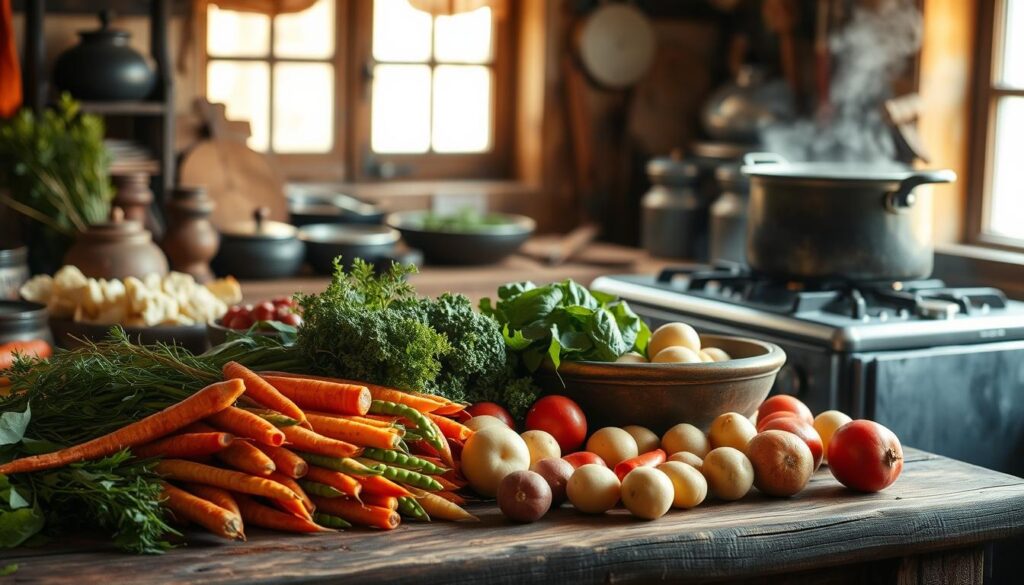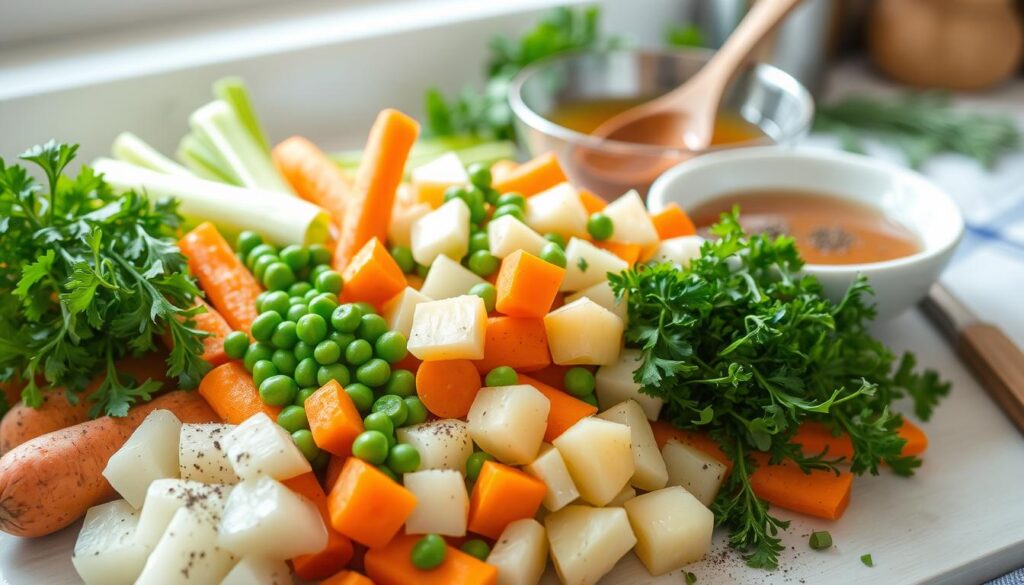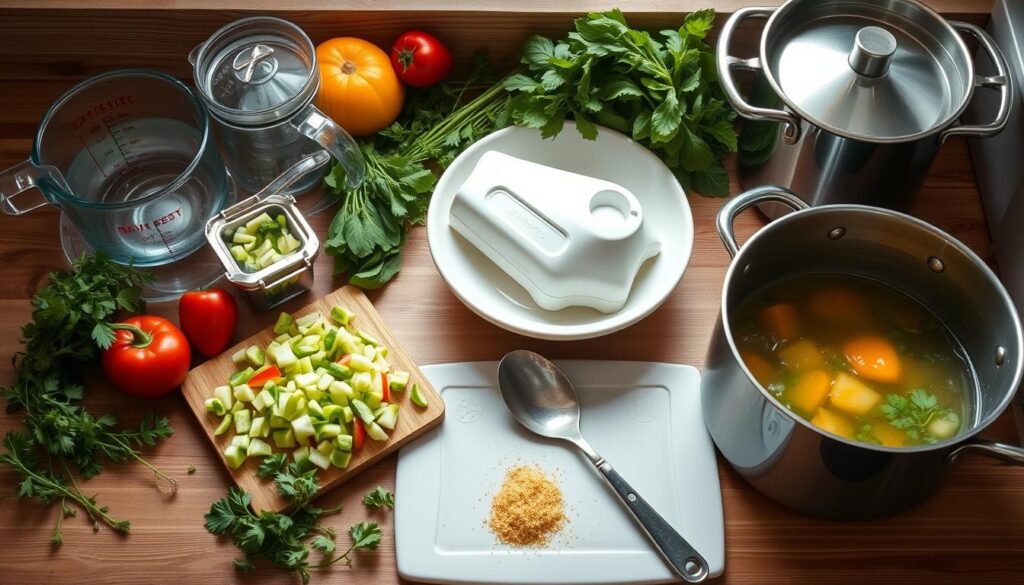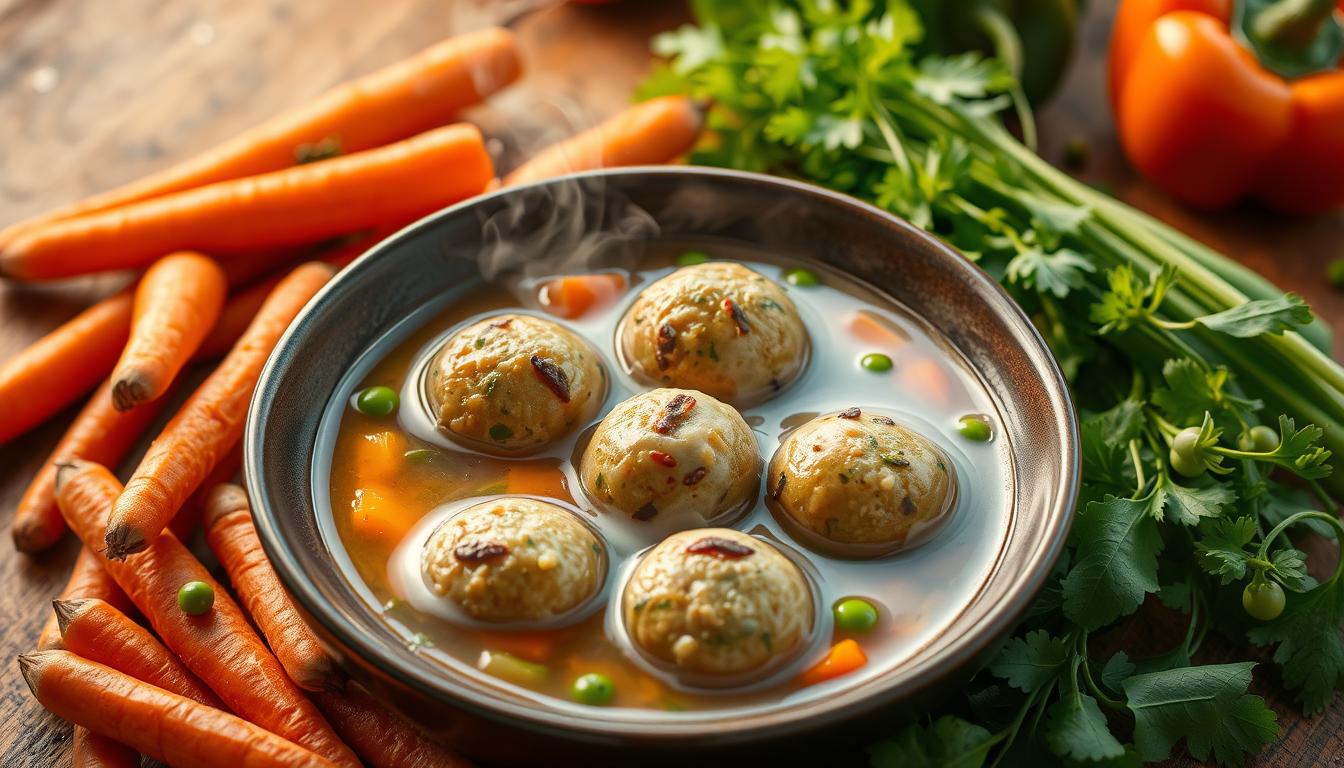Winter’s chill can make us feel hungry and cold. Vegetable soup balls are the perfect comfort food. They turn simple ingredients into a warm, tasty treat.
Imagine sitting around the table, watching steam rise from your bowl. Inside, tender vegetable balls swim in a rich broth. It’s a feast for your senses.
Vegetable soup balls are more than just food. They celebrate flavor, nutrition, and home cooking. Each ball is packed with lima beans, corn, and peas. They’re a nutritional powerhouse that fills you up and lifts your spirits.
The mix of ground beef and tomato base adds a special touch. It makes the soup extraordinary. Every bite is a journey of flavors that warms your heart.
Key Takeaways
- Vegetable soup balls offer a nutritious and comforting meal option
- Rich in protein and vegetables with balanced flavor profile
- Easy to prepare and adaptable to personal dietary preferences
- Supports healthy eating with low-calorie content
- Versatile dish suitable for family meals and meal prep
Understanding the Magic of Vegetable Soup Balls
Vegetable soup balls are a mix of nutrition, tradition, and comfort. They have won the hearts of food lovers worldwide. They add a fun twist to traditional soups.

The story of vegetable soup balls starts with creative cooks wanting to add more veggies to meals. A study from Iowa University shows that soup lovers tend to eat healthier. This is because soups are full of nutrients.
Cultural Roots and Significance
These soup balls are a tasty, meat-free option. They are loved in many cultures, each adding its own flavor and cooking style.
- Started as a way to use up leftover veggies
- Became a nutritious meal choice
- Adapted in many cooking traditions
What Makes This Dish Special
Vegetable soup balls are special because of their flexibility and texture. They can be made with many different veggies. This makes them perfect for those who love to try new things and care about their health.
Health Benefits Overview
« Soup is like a warm hug for your body and soul » – Unknown Nutritionist
The health perks of vegetable soup balls are impressive. Studies show that soup fans get more nutrients like:
- Fiber
- Vitamin A
- Magnesium
- Iron
- Potassium
Eating these soup balls can help prevent type 2 diabetes and boost overall health. They are packed with nutrients from veggies and other ingredients.
Looking for a cozy meal or a healthy choice? Vegetable soup balls are perfect for everyone.
Essential Ingredients for Perfect Soup Balls

Making tasty vegetable soup balls begins with picking the right ingredients. The vegetables you choose are key for flavor and nutrition. Look for fresh, top-quality veggies that mix well into your soup balls.
Here are the must-have ingredients for your vegetable soup balls:
- Root Vegetables: Carrots, parsnips, and sweet potatoes give a solid base
- Leafy Greens: Spinach, kale, or Swiss chard add nutrients and color
- Aromatics: Onions and garlic for deep flavor
Binding agents are vital for keeping your soup balls together. You have a few options:
- Breadcrumbs (the classic choice)
- Almond flour (a gluten-free option)
- Eggs (a natural binder)
« The secret to perfect soup balls is balancing your vegetable selection with the right binding agents. » – Chef Maria Rodriguez
When mixing your ingredients, aim for a mix of 20-25% root veggies, 15-20% leafy greens, and 10-15% aromatic veggies. This mix gives you a balanced taste and lots of nutrients.
Pro tip: Chop your veggies finely for even mixing and a smooth texture in your soup balls. Fresh, seasonal veggies always make the best soup balls!
Kitchen Tools and Equipment Needed
To make tasty vegetable soup balls, you need the right kitchen tools. Having the right soup ball cooking tools and kitchen equipment is key. This ensures your food preparation goes smoothly.

Having the right kitchen tools makes cooking easier and more fun. Here are the essential and optional tools you’ll need.
Essential Cooking Utensils
- Large mixing bowl (stainless steel recommended)
- Sharp chef’s knife (8-inch professional grade)
- Cutting board (at least two – one for vegetables, one for proteins)
- Measuring cups and spoons
- Wooden spoon or silicone spatula
Optional but Helpful Tools
- 1-inch spring-loaded cookie scoop for uniform soup balls
- Food processor for quick vegetable chopping
- Digital kitchen scale for precise ingredient measurements
- Instant-read thermometer for checking cooking temperatures
Preparation Space Requirements
Having a clean, spacious countertop is vital for efficient food preparation. Make sure your countertop is clean, well-lit, and all your tools are within reach. A 3-4 square feet area is usually enough for making vegetable soup balls.
Pro Tip: Clean and organize your workspace before starting to cook. This helps streamline the cooking process and makes cleanup easier.
Step-by-Step Preparation Method
Making the perfect vegetable soup ball recipe needs careful steps. You’ll turn simple ingredients into a tasty meal. This recipe makes 50-60 meatballs.
Start by collecting your fresh veggies. You’ll chop:
- 4 carrots
- 3-4 celery stalks
- 1 yellow onion
- 2-3 garlic cloves
For the vegetable soup ball prep, finely chop the veggies. Precision in chopping is key to a well-balanced dish.
« Cooking is about passion, so it may look slightly temperamental in a way that it’s too assertive to the naked eye. » – Gordon Ramsay
Mix your chopped veggies with other important ingredients. Use a cookie scoop for uniform size. Aim for balls about 3/4 inch in diameter. This ensures even cooking and looks great.
- Combine chopped vegetables
- Add binding ingredients
- Mix thoroughly
- Scoop and shape balls
- Prepare for cooking
Pro tip: Make sure your soup balls hit 165°F for food safety. Browning takes 3-4 minutes per batch stovetop.
Broth and Base Preparation Techniques
Making the perfect soup broth is an art. It turns simple ingredients into a tasty meal. Knowing how to make a great base can make your vegetable soup balls stand out.
When making soup broth, aim for a rich, flavorful base. This base should enhance your soup balls. The goal is to mix ingredients and techniques that boost taste and health.
Creating the Perfect Tomato Base
A strong tomato base is a great start for your soup. Here’s how to make a tasty base:
- Choose ripe, top-quality tomatoes
- Roast tomatoes to deepen flavor
- Blend until smooth for a uniform texture
- Strain to get rid of seeds and skin
Seasoning and Flavor Enhancement
Getting seasoning right can make your soup amazing. Try these tips to add flavor:
- Add herbs and spices gradually
- Use fresh ingredients for the best taste
- Try new flavor mixes
Pro tip: Start with less seasoning and adjust to taste.
Cooking Time and Temperature Guide
Cooking your soup right is key for great flavors. Here are some tips:
- Use 1-2 soup balls per 4 cups of water
- Cook for 1 minute to dissolve
- Simmer for about 15 minutes
- Heat in the microwave in 30-second intervals until dissolved
By using these techniques, you’ll make a meal that’s both tasty and healthy. It will please your taste buds and nourish your body.
Vegetable Selection and Preparation
Choosing the right vegetables is key to making delicious soup balls. They should be full of flavor and good for you. The right mix of vegetables can turn a simple dish into a work of art.
Start with these recommended vegetables for your soup balls:
- Carrots: Peel and chop into small, uniform pieces
- Frozen lima beans: Convenient and nutritious
- Corn: Fresh or frozen works perfectly
- Optional vegetables: Rutabaga, turnips, parsnips
Learning how to chop vegetables is important. Use a sharp knife for even cuts. For root vegetables like carrots, try these tips:
- Wash and peel vegetables thoroughly
- Cut into uniform small cubes
- Aim for pieces roughly the same size
« Great soup starts with great vegetables » – Professional Chef Recommendation
Think about the nutritional value and taste of your vegetables. Mix different colors and textures for a better soup ball. Frozen veggies can be just as tasty as fresh ones, making things easier.
Making and Shaping the Perfect Soup Balls
Making delicious soup balls needs precision and care. Your technique can make or break the dish. Let’s explore the art of soup ball preparation to improve your cooking skills.
Mixing Techniques for Optimal Consistency
Mastering soup ball shaping begins with mixing. Use these key techniques to keep your soup balls together:
- Mix ingredients gently to avoid overworking the mixture
- Use cold hands or slightly wet palms when forming balls
- Combine dry and wet ingredients well before shaping
Size and Shape Guidelines
Consistency is crucial for soup balls. Aim for uniform sizes for even cooking:
- Recommended ball size: 1/2 to 3/4 inch diameter
- Use a small ice cream scoop for consistent sizing
- Roll balls between your palms gently
« The perfect soup ball is like a culinary work of art – small, uniform, and packed with flavor. »
Troubleshooting Common Shaping Issues
Having trouble with soup balls? Here are some tips to help you succeed:
- Balls falling apart: Add more binding ingredients like breadcrumbs
- Too dry mixture: Add a small amount of liquid
- Sticky hands: Keep hands lightly moistened or use cooking spray
With these techniques, you’ll make soup balls that are consistently delicious and perfectly shaped. Remember, practice makes perfect. Don’t get discouraged if your first attempts aren’t flawless.
Cooking Methods and Timing
Learning the right way to cook soup balls can change your cooking game. The secret to great soup balls is in the temperature and cooking time. How you cook them affects their texture, taste, and quality.
There are many ways to cook soup balls:
- Simmering in Broth: The most traditional method
- Baking for a crispy exterior
- Air frying for a healthier option
- Gentle poaching for delicate texture
For the classic simmering method, follow these steps:
- Drop soup balls carefully into bubbling broth
- Reduce heat to maintain a gentle simmer
- Cook for 30 minutes, ensuring consistent temperature
- Check internal temperature reaches 165°F
« Patience and precise temperature control are the secrets to perfect soup balls. »
Keeping the temperature steady is key. Aim for a simmer between 185-205°F. This helps your soup balls cook evenly. Use a digital thermometer to keep an eye on the temperature.
The cooking time depends on the size of your soup balls. Aim for about 1 tablespoon per ball. This usually takes 25-30 minutes. Smaller balls might need 15-20 minutes, while bigger ones could take up to 40 minutes.
Storage and Reheating Guidelines
Keeping your vegetable soup balls tasty means paying attention to how you store and reheat them. The right methods ensure your homemade soup stays delicious, whether it’s for a quick meal or a future date.
Proper Storage Techniques
Here are the key steps for storing soup:
- Cool the soup completely before storing
- Use airtight containers to prevent contamination
- Refrigerate within 2 hours of cooking
- Store in the refrigerator for up to 5 days
Freezing Soup Balls
Freezing your soup balls is a great way to keep them fresh. Follow these tips:
- Allow soup to cool completely
- Use freezer-safe containers or heavy-duty freezer bags
- Leave about 1 inch of space at the top for expansion
- Freeze for up to 3 months
« The secret to great leftover soup is proper storage and careful reheating. » – Culinary Expert
Reheating Instructions
Here’s how to reheat your soup:
- Microwave: Heat for 2 minutes, stirring halfway through
- Stovetop: Warm over medium heat, stirring occasionally
- Thaw frozen soup overnight in the refrigerator
- Ensure soup reaches 165°F for food safety
Pro tip: If your soup is too thick, add a bit of water or broth. This will make it just right again. Enjoy your soup balls as if they were just made!
Serving Suggestions and Pairings
Turn your vegetable soup balls into a special meal with these creative ideas. The right food pairings can make a simple dish unforgettable. It’s all about the flavors and textures.
« A great meal is about the perfect balance of flavors and textures »
From classic comfort to gourmet, your meal suggestions can vary. Here are some top pairings for your vegetable soup balls:
- Crusty artisan bread for dipping
- Fresh mixed green salad with light vinaigrette
- Crispy saltine crackers or buttered toast
- Roasted vegetables as a side dish
- Grilled cheese sandwich for ultimate comfort
Think about the occasion when planning your meal. For casual dinners, try simple sides like crackers and a quick salad. For elegant gatherings, choose gourmet sides that highlight the soup’s flavors.
These pairings offer both nutrition and satisfaction. A balanced meal can include protein-rich sides or a light dessert. Try different combinations to find your favorite soup serving ideas.
« Creativity in the kitchen transforms ordinary meals into extraordinary memories »
Conclusion
Your journey to make the perfect vegetable soup balls recipe is just starting. This healthy comfort food is more than a meal. It’s a culinary adventure waiting for you in your kitchen.
Every time you make these soup balls, you’ll learn something new. You’ll discover new techniques and flavors. You can also make your homemade soup your own.
The beauty of vegetable soup balls is in their simplicity and flexibility. This recipe is great for both new and experienced cooks. You can try different vegetables, spices, and cooking methods to make it your own.
Cooking is all about love and creativity. Your vegetable soup balls will nourish your body and bring joy to your table. Start with the basic recipe, then let your imagination run wild. The most important thing is the passion you put into your cooking.
We hope this guide inspires you to enjoy making delicious, healthy meals. Your kitchen is ready to turn simple ingredients into amazing dishes. Happy cooking!

